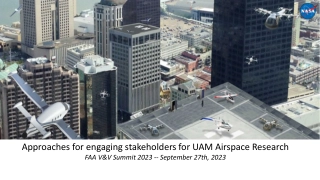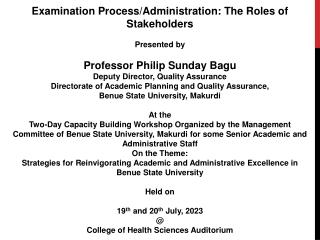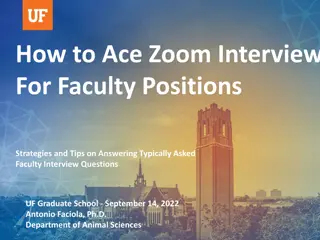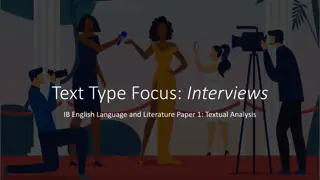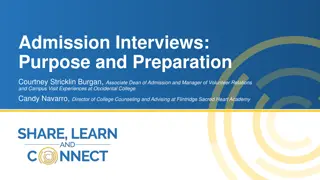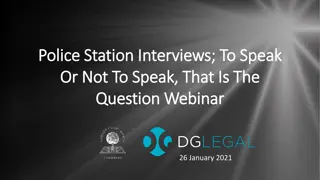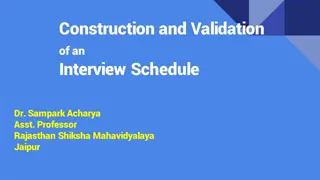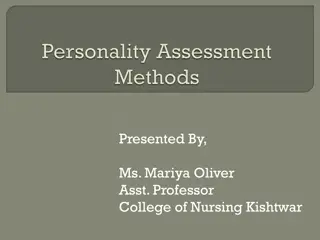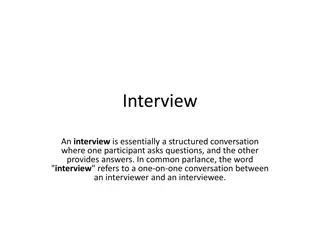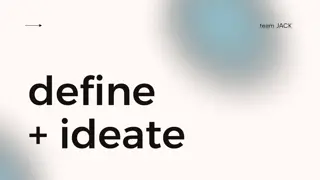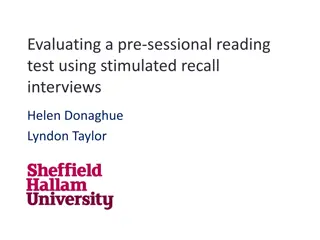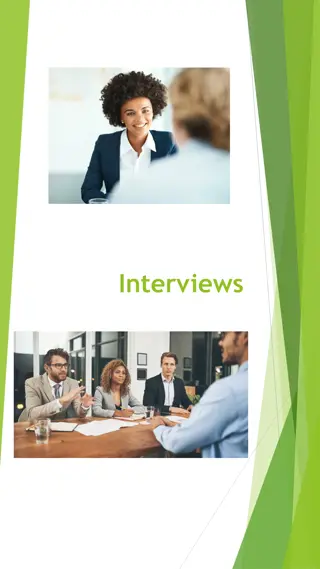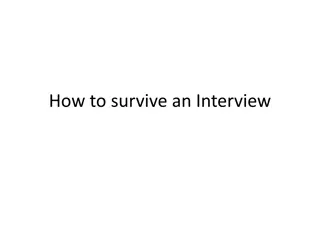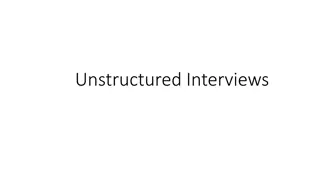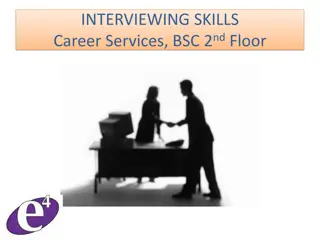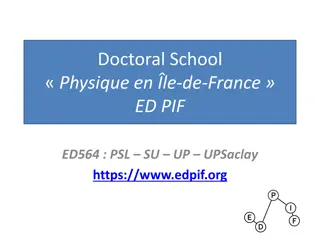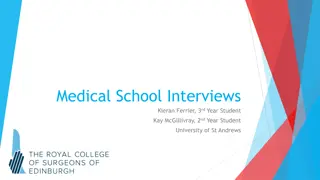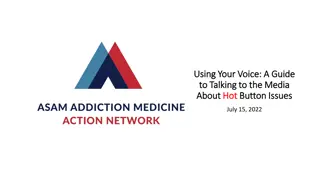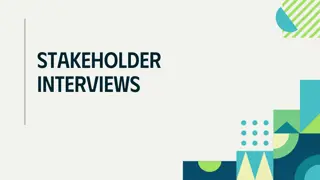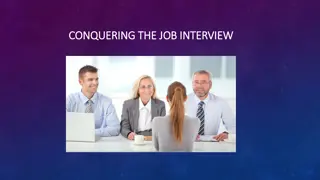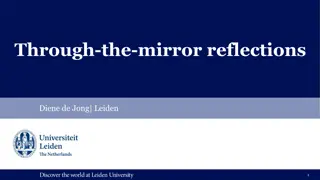Engaging Students as Stakeholders in Research Interviews
Explore how researchers can position students as stakeholders in research interviews, focusing on utilizing the Personal Meaning Making Map (PMMM) to create a welcoming dialogue opportunity. The presentation discusses theoretical frameworks, the importance of honoring stakeholders, building relationships, and ethical considerations. It emphasizes the shared narrative around learning through passion projects and highlights the researcher's role in empowering students to share their experiences and ideas. The methodology involves student-directed interviews using the PMMM approach.
Download Presentation

Please find below an Image/Link to download the presentation.
The content on the website is provided AS IS for your information and personal use only. It may not be sold, licensed, or shared on other websites without obtaining consent from the author.If you encounter any issues during the download, it is possible that the publisher has removed the file from their server.
You are allowed to download the files provided on this website for personal or commercial use, subject to the condition that they are used lawfully. All files are the property of their respective owners.
The content on the website is provided AS IS for your information and personal use only. It may not be sold, licensed, or shared on other websites without obtaining consent from the author.
E N D
Presentation Transcript
Welcoming Dialogue- Positioning students as stakeholders in the research interview. Ms Fiona Trapani and Dr Christine Redman
Overview of presentation Introduction- Why and how a researcher can utilise a PMMM* as a Welcome dialogue opportunity Theoretical frame - meaning making Outline of Method- relationship dynamic Elsa case study- example of relationship building Conclusion- Welcoming Dialogue- as a Method *PMMM: Personal Meaning Making Map (Falk et al 1997)
Introduction (why and how) Problem, ideas and aims PhD Research - Important to me Why should the students in my sample care? -The need to honour stakeholders Shared data, Shared story, Shared ownership - conjointly constructed narrative around learning through passion projects . Ethics- Pairs of students, time, consent Building relationships -visiting researcher- becomes an insider perspective. PhD is exploring students perceptions of their learning in creative & contemporary contexts? (Passion Project- student inquiry) Start with a picture
Literature- underpinning methodology Agency (Giddens, 1993) Me as researcher Students as stakeholders sharing their experiences and ideas around learning. Identity (Linehan & McCarthy 2000) Initial perception of Adult and child Shift focus to empower child. Rights and Duties (Redman & Rodrigues, 2008) Ethics- Clearly outlines non-negotiable Researcher as supportive outsider
Literature- underpinning methodology Story lines and positioning theory (Harre & Van Langenhove, 1996) Conversation as narrative- dialogical construction of meaning- Do and Say Cover, Secret and Sacred stories (Clandinin and Connelly, 1996) Building relationships to generate data that gives more than a cover story.
Methodology- creating a safe place Exploring student s perception of learning in passion project . 2 Interviews- PMMM* focused, student directed a) Discussion and drawing PMMM (Falk et al, 1997), with reflection on PMMM. b) 2 or more weeks later: Semi-Structured Interview, reflecting on PMMM. c) Students choose Pseudonym d) Students have right of reply to examine and edit the transcripts. *PMMM: Personal Meaning Making Map (Falk et al 1997)
So what? Student perspective Data indicates that students enact their agency to show aspects of their identity. I made 2 additional visits to her school, at Elsa s request, as she wanted to share her next pieces of work with me. Identity- PMMM clear student control, and identification that I am a supportive adult. Rights and duties- recognised, respected and developed.
So what?- researcher perspective The research interview is seeking to develop a dialogical relationship in a short time frame. Welcoming Dialogue encompasses: Agency of researcher and student to co-author storylines. Identity of researcher and student; be prepared to shift to share data, story and ownership. Rights and Duties may shift- don t fear this unknown -be mindful of ethics (Rachael s caution yesterday).
Methodological frame- Roberts (1996) triangle Conjointly constructed interview Agency, Identity and Rights and Duties = strong narrative and story developed for further analysis
References Clandinin, D. J., & Connelly, F. M. (1996). Professional Knowledge Landscapes: Teacher Stories, Stories of Teachers, Schools Stories, Stories of Schools. Educational Researcher, 25(3), 24 30. Falk, J. H., Moussouri, T., & Coulson, D. (1997). The effect of Visotors agendas on Museum Learning. Curator, 41(2), 107 120. Giddens, A. (1993). New Rules of Sociological Method (2nd ed.). Stanford, California: Polity Press/Blackwell Publishers Ltd. Harre, R., & van Langenhove, L. (1999). Positioning Theory: moral contexts of intentional action. Oxford: Blackwell Publishers Ltd. Linehan, C., & McCarthy, J. (2000). Positioning in Practice: Understanding Participation in the Social World. Journal for the Theory of Social Behaviour, 30(4), 435 453. doi:10.1111/1468-5914.00139 Redman, C., & Rodrigues, S. (2008). Researching the relationships in the Technologies of Self : Habitus and Capacities Oughtness influences discursive practices. In AARE 2008 International Education Research Conference, Brisbane, Australia. (pp. 1 10). Roberts, D. A. (1996). Dialogue Epistemic Authority for Teacher Knowledge : The Potential Role of Teacher Communities- A Response to Robert Orton *, 26(4), 417 431.


